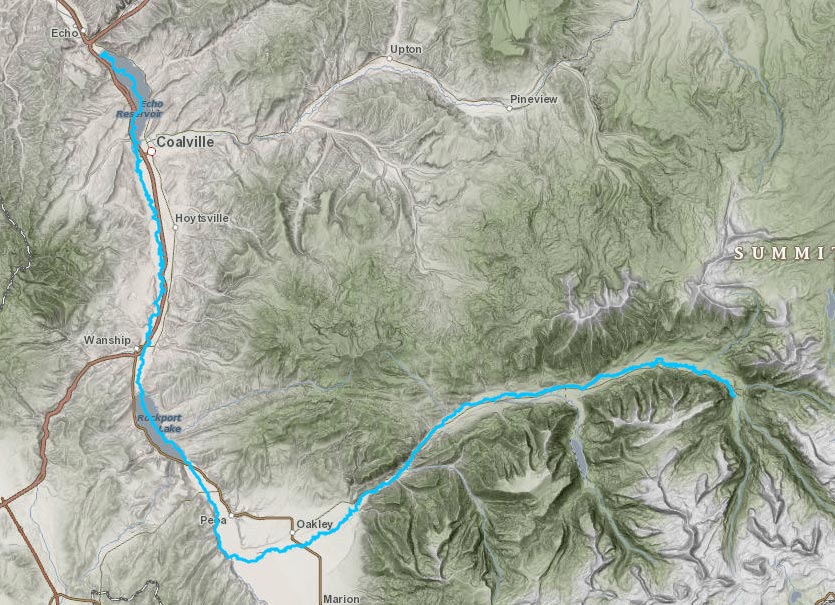Recreational access to Utah's public waters
Here's what anglers need to know before fishing Utah streams.
Per recent Utah Supreme Court decisions and Utah's Public Waters Access Act (Utah Code § 73-29-101, et seq.), recreational water users — including anglers, kayakers, tubers, hunters and others — need to follow the laws affecting stream access.
Statewide, except for the upper Weber River (Holiday Park to Echo Reservoir). All recreational water users need to follow the laws affecting access, which are outlined in the frequently asked questions section, below.
Weber River (Holiday Park to Echo Reservoir). Right now, access laws on the upper Weber River are different than access laws for other waters in the state. In November 2017, the Utah Supreme Court issued a decision in the case of Utah Stream Access Coalition v. Orange Street Development. The court's ruling modified the rules related to public recreational access along a segment of the Weber River in Summit County. If you're planning to fish or recreate on the upper Weber River between Holiday Park and Echo Reservoir, please review and follow the laws affecting access.
Common questions about recreational access in Utah
What is the current law?
In 2010, the Utah Legislature passed H.B. 141: Recreational Use of Public Water on Private Property. That law remains in effect.
What does the law prohibit?
The law does not allow recreational water users (including anglers, kayakers, tubers, hunters and others) to walk on the private bed of a public waterbody. This means that if you are fishing or recreating in public water that flows over private property closed to trespass, you may not walk on the land beneath the water without obtaining landowner permission.
What is trespass?
To trespass is to enter someone's property unlawfully. Landowners close their property to trespass by posting a notice or otherwise communicating that access is prohibited. Irrigated pastures, cultivated lands and certain fenced areas are presumed closed to trespass. To review Utah's trespass laws, see Utah Code Sections 23-20-14, 76-6-206 and 76-6-206.3.
What does the law allow?
The current law allows you to float on the surface of the water, even if you're floating over private property that is closed to trespass. It also allows you to fish while floating. Your right to float only applies under the following conditions:
- Water volume. The water must have sufficient width, depth and flow to float your vessel.
- Stopping prohibited. You and your vessel must move with the current and not anchor or stop.
- Public water. The water must flow in a natural channel, or it must collect in a natural lake, pond or reservoir on a natural channel.
- Excluded water. The public easement to float does not apply to any of the following waters on private property:
- A jurisdictional wetland (as defined in 33 C.F.R. 328.3)
- An impounded wetland, which means a shallow body of water formed or controlled by a dike, berm or headgate
- A migratory bird production area (as defined in Utah Code Section 23-28-102)
What if I encounter an obstacle while floating?
Your right to float includes the following:
- Incidental touching. You may incidentally touch the private bed as required for safe passage and continued movement of you and your vessel.
- Portage. You may portage around a dangerous obstruction in the water, as long as you use the most direct route that follows closest to the water.
Where can I access the water to float and fish?
If you want to fish while floating, you must access the water at a lawful access point. This could include a highway right-of-way, public property or private property with written landowner permission.
Where can I fish without obtaining permission?
There are still thousands of places you can fish without obtaining landowner permission. You do not need permission to:
- Fish while floating over private property.
- Fish on public property where the activity is authorized by the managing agency. This applies to fishing on property owned by the U.S. Forest Service, the Bureau of Land Management, the DWR and other public agencies.
- Fish on private property that is not closed to trespass.
If possible, try to communicate with landowners before you float over property closed to trespass. It is courteous and always appreciated.
The DWR has also worked with other agencies and private landowners to obtain public access to stretches of the following rivers and streams: Duchesne River, Little Bear River, Ogden River, Provo River (middle section), Salt Creek, Sanpitch River, Spanish Fork River, Strawberry River, Thistle Creek, Weber River and many others. To find a waterbody where you do not need permission to walk the bed, contact the DWR office in the region where you want to fish.
Where is the DWR stocking fish now that the law has changed?
Most fish stocking occurs in Utah's reservoirs, lakes and community ponds. The DWR stocks very few rivers and streams, all of which have guaranteed public access. (See an up-to-date list of recently stocked waters.) The DWR only stocks public waters that flow over private land when biologists are re-introducing native fish to an area as part of Utah's Native Fish Restoration Program. This type of stocking is typically short term and has played a key role in keeping cutthroat trout and other native fish — such as the least chub — off the Endangered Species List.
The above information reflects the opinions and interpretations of the Utah Department of Natural Resources, Division of Wildlife Resources on H.B. 141. The opinions and interpretations presented are not binding on courts, prosecuting attorneys or other law-enforcement agencies. They are provided solely for general information and do not represent legal advice or counsel.















